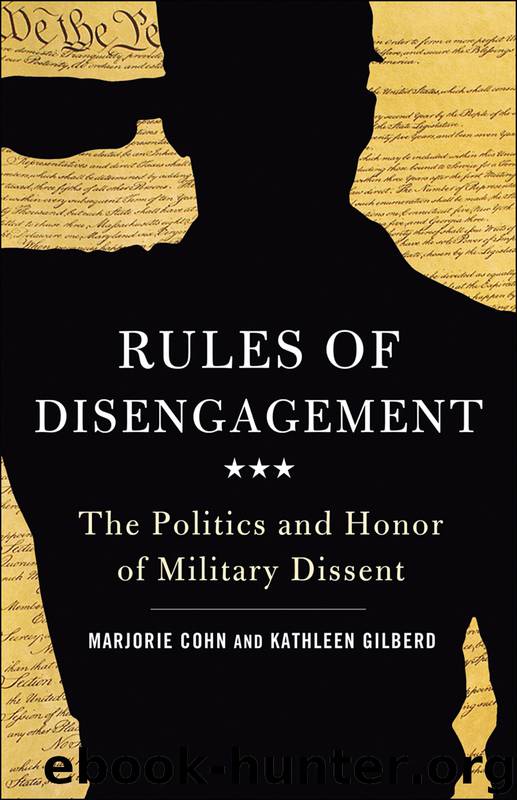Rules of Disengagement by Cohn Marjorie; Gilberd Kathleen; & Kathleen Gilberd

Author:Cohn, Marjorie; Gilberd, Kathleen; & Kathleen Gilberd
Language: eng
Format: epub
Publisher: NYU Press
Published: 2009-03-16T16:00:00+00:00
Training Soldiers: Power, Violence, and Sex
The Department of Defense periodically tries to identify the underlying causes of the high numbers of assault and harassment cases in the services. In reality the studies usually identify other symptoms rather than causes. Failure or refusal to examine the basic reasons for a culture that not only tolerates but sometimes encourages harassment and assault prevents the military from addressing those reasons. As a result, DoD’s plans for improvement have largely been cosmetic and unsuccessful.
DoD has identified such causes as lack of clarity about policy, failure to train soldiers to understand what sexual harassment is, and paucity of follow-up training in prevention and response. Despite the requirement of repeated trainings, including prede-ployment briefings, military officials continue to say that male soldiers don’t understand the definitions and often harass out of ignorance. The military has long provided materials for GI training programs and information on what harassment entails, with specific definitions and examples—but these are often not used at local commands. Studies make general reference to a culture that tolerates sexual harassment and a poor “command climate” on these issues.
The military has cited alcohol and party culture as contributing factors to continued sexual harassment, along with the pressures of working in close quarters with women (read: women being allowed to serve in traditionally male jobs) and societal problems. The military’s early claims that recruits simply brought sexist attitudes and behaviors with them from the civilian world, or more recent assertions that lowered enlistment standards cause higher incidents of misconduct, have been hard to sustain. They fly in the face of the large disparity between civilian and military assault figures and the reports of a much higher incidence of rape in communities located adjacent to military bases than in other, civilian, areas. Some, but not many, military reports acknowledge that military sexual harassment provides a favorable climate for sexual assault, as congressional reports and critics have been saying for some years.
But the military has never addressed the underlying causes of sexual harassment and assault, and it cannot do so unless it accepts fundamental criticism of the way it has come to train and sustain its forces. At the heart of these problems is the fact that sexual harassment and assault result in large part from the intentional use of sexism—sexual imagery and sexual brutality—in military indoctrination and training.
During basic training male soldiers are taught to equate manliness and sexual prowess with proficiency as a warrior; sexual violence with military violence; and disobedience or nonconformity with weakness, femininity, and negatively portrayed homosexuality. Drill instructors use crude parallels between recruits’ rifles and penises when discussing maintenance and use of weapons, and they emphasize violent sexual imagery in combat training. This use of sexual violence is routine, showing up in everything from marching chants to motivational taunts.
Such training, like the conscious use of racial stereotypes and names, encourages objectification of and brutality toward a perceived enemy. The training creates soldiers who obey orders without thinking as many are conditioned to engage in the most heinous violence.
Download
This site does not store any files on its server. We only index and link to content provided by other sites. Please contact the content providers to delete copyright contents if any and email us, we'll remove relevant links or contents immediately.
Steroids: History, Science, and Issues by Standora Joan E.; Bogomolnik Alex; Slugocki Malgorzata(1195)
A Practical Guide to International Arbitration in London by Hilary Heilbron(1085)
Adrift by Steven Callahan(1033)
Reclaiming History by Vincent Bugliosi(1021)
Persuasion by Owner(1014)
The Nuremberg Interviews by Leon Goldensohn(991)
Dog Company: A True Story of American Soldiers Abandoned by Their High Command by Lynn Vincent & Roger Hill(980)
40 Days and 40 Nights by Matthew Chapman(969)
Poisoned by Jeff Benedict(960)
Last Narco by Beith Malcolm(936)
The New Whistleblower's Handbook by Stephen Kohn(921)
Introduction to the study and practice of law in a nutshell by Kenney F. Hegland(897)
Kafka's Last Trial by Benjamin Balint(849)
Lincoln's Code by John Fabian Witt(843)
A Passing Fury by A. T. Williams(826)
Japanese War Crimes during World War II: Atrocity and the Psychology of Collective Violence by Frank Jacob(812)
Eichmann in Jerusalem by Hannah Arendt(801)
Dog Company: A True Story of American Soldiers Abandoned by Their High Command by Roger Hill & Lynn Vincent(795)
A Court of Refuge by Ginger Lerner-Wren & Rebecca A. Eckland(786)
